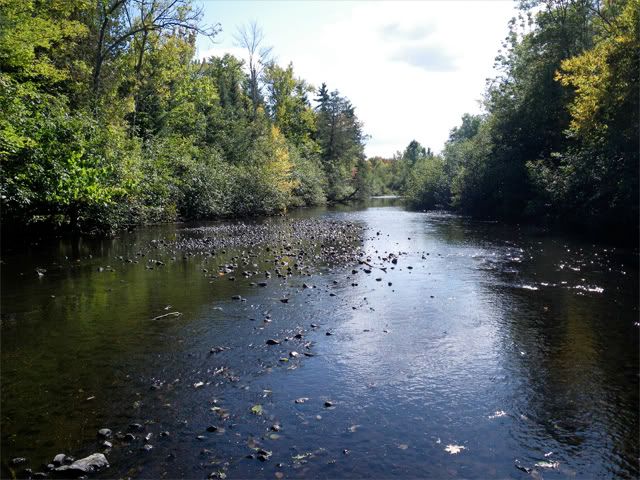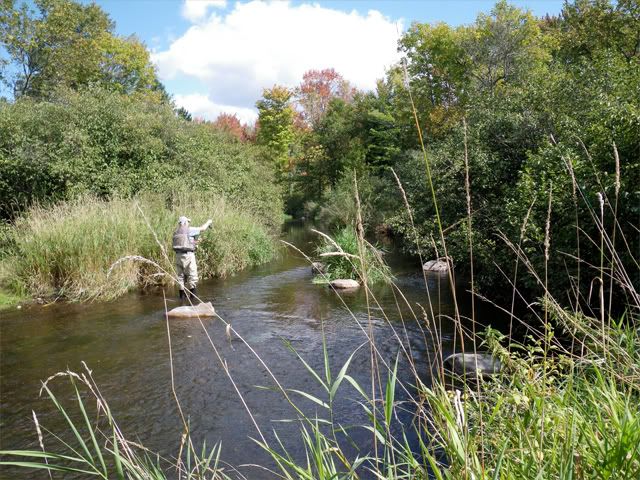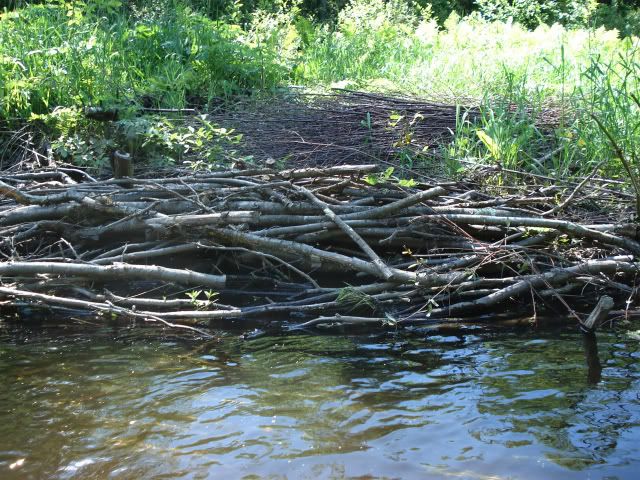
In the middle of summer this hole is kept cool by a tiny spring feeding in. The cooler water has more oxygen in it and the trout will travel a along ways to find cooler water.
About 20 years ago I went on a shocking crew with the Wisconsin Department of Natural Resources. I tried to guess where the big trout would be located during the shocking. I was correct some of the time but there was something that overruled my guesses and was fairly accurate. I use it every time I fish these days.
The crew shocking also took the stream temperatures each area they shocked. Not just a general temperature sampling, a temperature was taken every 10 yards. More trout were caught in the cooler water temperature areas. The lead DNR guy told me that there was a spring nearby. It was a really tiny one and if we didn’t know it was there from years past we would walk right by it. From years past shocking he knew there would be lots of fish in the area. The air temperature was 70 degrees that day.
We came up to this area he talked about. I took the temperature thirty yards downstream of the spring. We started shocking there. As we got closer to the spring the temperatures went down and the numbers of trout went up. The biggest trout shocked basically had their noses directly where the tiny spring fed in. The temperature difference from first measure to the spring differed 12 degrees. The DNR guy explained to me that springs are like magnets to trout “year round” because the springs keep a constant temperature. In hot summer weather, trout will travel hundreds of yards to areas with springs.
I asked him to elaborate more about the year round idea. Cooler water in summer carries more oxygen. The surrounding water gets really warm and the warm water can not hold as much oxygen. I was curious about the winter a little more. Those springs keep that constant temperature year round. In winter when the water temperatures are frigid the trout migrate to holes that have a spring near or in it. The springs actually make the holes warmer in winter and this attracts trout and bait fish and many invertebrates.
You need to get a decent thermometer that clips to your vest with a long cord. It needs to be a tough one that is not made of glass. I recommend the all metal ones that come in a plastic sheath with a dial on the top with big numbers on it to read. When you use them, take the temperatures about 3/4s the way to the bottom of the area you are measuring. Hang on to the top of the thermometer on the dial area so your fingers don’t influence the measuring. Keep it under the water for a 10 second count.
I did a check of my log books from the last 35 years. There was one reoccurring theme throughout all those years. There were actually lots of things to ponder as I read them. My log books are fairly standardized. They go chronologically and are from the entire year. They even included closed season scouting. About 20 years ago I added stream temperatures to my log books because of my experience I had with the shocking crew.
The date is first. Trout caught and sizes is next. Every time I fish I take the stream temperature. I take the stream temperature even when scouting. If I see anything out of the ordinary I put that in too. I am still clued in to my temperature idea and look for springs feeding in during the winter. I look for breaks in iced over streams. I take the temperatures there and they are typically warmer. Some springs are not evident and feed directly in from the stream bed.
My log book also has where in the holes I caught the trout. I try to give a reason I believe the trout was located there. I don’t just put big trout in there. I put all trout caught in there. After I fish a hole I some time actually go in the hole and see if my reading of the hole was correct. I get to feel out the bottom terrain and learn from the outing. This teaches me how to read a hole prior to fishing it the next time and it helps with similar holes upstream.
The log includes weather conditions and water clarity. Hatches or lack of are noted. Lures/flies used and equipment is also noted. Anyone I fish with I include in the log book. If you haven’t figured it out yet? It is the log book. You can have the most expensive gear and it means nothing unless you know what you are doing prior and where to go. Log Books are the Trout Angler’s Most Valuable Tool and a thermometer is a close second.

I know from my log book that there is a small spring trickling in on the right side of this hole. There is six degrees warmer water right there. This is where I want to target.


